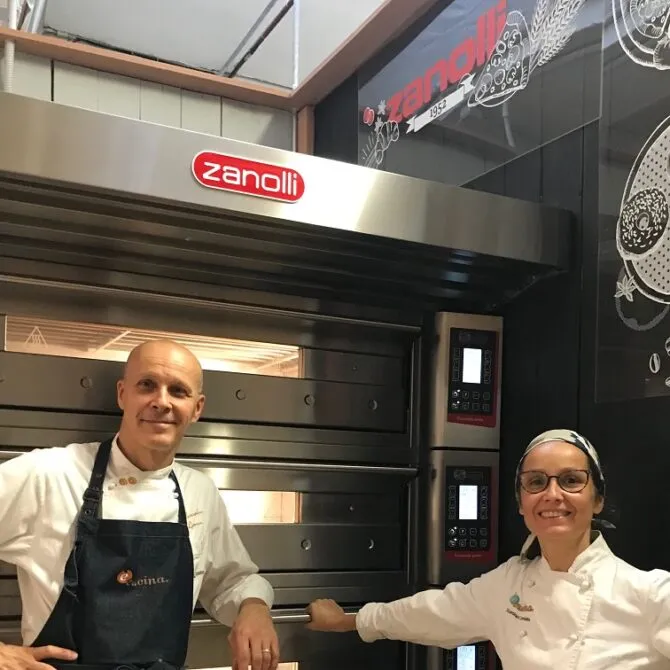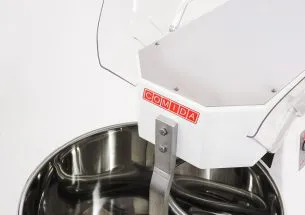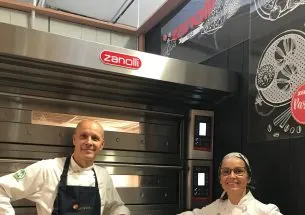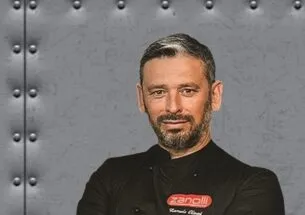 Eclectic, sustainable and in step with the times, èCucina is one of Zanolli’s Partner Schools. The school is also equipped with a Bistrot corner where it is possible to taste the dishes prepared in the teaching labs. Its Director, Alessandro Lasferza, highlighted how his multidisciplinary approach to teaching and baking and our multipurpose equipment are in perfect tune.
Eclectic, sustainable and in step with the times, èCucina is one of Zanolli’s Partner Schools. The school is also equipped with a Bistrot corner where it is possible to taste the dishes prepared in the teaching labs. Its Director, Alessandro Lasferza, highlighted how his multidisciplinary approach to teaching and baking and our multipurpose equipment are in perfect tune.
Fashion, artisanship, decoration, design and …bread! Is there a common thread? How come you chose bakery among the culinary arts? How do you harness your past experience for your current activity?
There is a common thread indeed, because all these experiences involve manual skills and craftsmanship, and for me bread-making requires a lot of creativity too. Besides, when I was working in design and decoration, I used to handle a very ancient raw material: lime. Then too, it was a matter of kneading. We can say that I moved from kneading a non-edible but nice to look at element to kneading one that is both nice to look at and good to eat. And since my wife works in the kitchen too and she uses knives and scissors, I figured it would be best for me to have my own separate working space…
Are there fashions and trends in the bakery world too?
For sure there are fashions in the bakery world too. Especially during this lockdown period that forced us to stay at home for a long time, the trend of sourdough has skyrocketed. It is a much talked-about subject yet, even among professionals, not so many have the real sourdough and refresh it on a daily basis. Another trend, a very positive one in my opinion, is the use of alternative flours to soft wheat flours. This enables the bakers to achieve different results in terms of texture and taste.
In your labs you have our electric static oven Teorema Polis, ideal for bakery. How is your oven configured and how do you use the various elements (vaporizer, refractory stone…)?
In our laboratory, we have a Teorema Polis electric static oven with three cooking chambers, two of which are for ordinary bakery products, one for larger-size products. There is a proofing cabinet underneath. All three chambers are equipped with a vaporizer, which proves to be very useful, especially when baking bread. The refractory stone allows for the ideal development of any bakery product. Though we have the latest edition of the digital control panel, in the School we mainly use the manual functions, as they come in handy when you need to teach students how to manage cooking parameters, power at the top and at the bottom, vapor…
 What kinds of bread do you bake and how do you modify the oven’s settings accordingly? And for Easter cakes and panettone? Any advice?
What kinds of bread do you bake and how do you modify the oven’s settings accordingly? And for Easter cakes and panettone? Any advice?
For our teaching activity in the School, we produce small buns of various shapes as well as larger loaves. Teaching how to manage the different cooking methods is fundamental for us. For this reason, we make our students work essentially with the manual functions so that they get trained to understand when to perform the right action at the right time, such as activating the vapor discharge valve. For the Bistrot on the other hand, we produce 3-4 types of large loaves, which we then cut into slices. In this case, in order to let the bread grow properly, we use large amounts of steam at the beginning of the cooking process as well as, if need be, towards the end of it.
As for panettone and Easter cakes, we always bake them in the taller cooking chamber of Teorema Polis. The cooking settings depend much on the idea that one has. Our method is to start with a low temperature, then raise it when the products are about to reach full growth. And I’ve got to say it works. I learnt this technique from Maestro Rolando Morandin and I actually really enjoy cooking slowly, with an initial low temperature gradually raised. I use this technique to cook other products as well.
Ingredients, dough preparation, baking: by modifying just one of these elements, the result may differ a great deal. How much, for instance, can the different kneading methods influence the final product?
It is true that in the bakery world, even the slightest adjustment of just one of these factors can have a great impact on the final result, which is why I think it is better to modify one of them at a time. Take the Comida kneaders for instance. To make panettone, I can use either the Galassia spiral kneader or the Eracle dipping arms kneader and obtain different results. I personally prefer Eracle, as it incorporates more oxygen into the dough. For the pizza on the shovel too, the dough prepared with the dipping arms kneader may be better, because this kind of pizza demands much oxygenation. Each tool, as well as each ingredient and each cooking method, has its own ideal use.
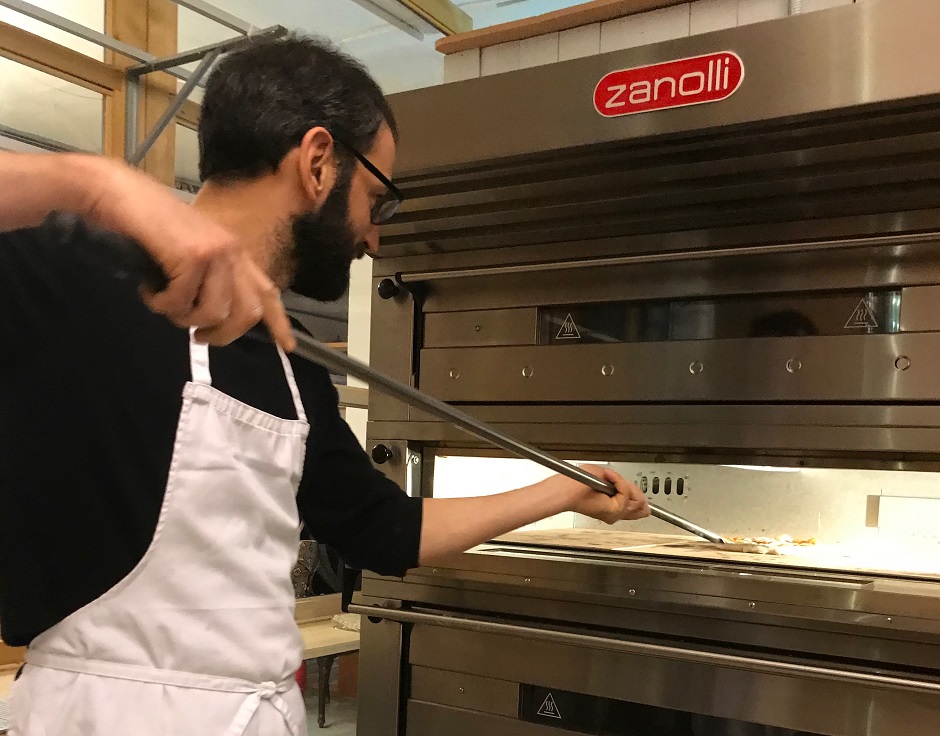 What are your methods to reduce food waste and energy consumption?
What are your methods to reduce food waste and energy consumption?
Concerning food waste, energy consumption and green attitude in general, hot topic of the moment, both in the School and in the Bistrot we have adopted plastic-free measures and we use biodegradable material. With products and raw materials, we abide by the principles of eco-sustainability and full consumption of everything that is purchased. A courgette should be used in its entirety, why not the white part for one thing and the green part for another. Our endeavor is to eliminate all waste and keep energy consumption at its lowest. The Teorema Polis for example has the Economy function and we always use it to pre-heat the oven, for it allows us to save a great amount of electricity.
You are director of èCucina’s Junior Bakery Academy. What’s your impression on teaching to juniors and what do they teach you?
Teaching kids can always be a very educational experience. I mainly try to make them learn the basics. Given their age – ranging from 9 to 13 years – I avoid teaching too complicated notions, preferring practice and simple content. You learn something from them every time, because they ask you tons of questions and even the weirdest and most unusual questions may well end up triggering the idea you’ve been looking for for a while. Dealing with kids is very rewarding. During the lockdown period, we organized online courses and we sometimes reached an audience of 60 kids who cooked and prepared bakery products with us through the camera. It was awesome!
How has the Zanolli equipment enhanced your work? Do your students find it easy to use?
In addition to the Teorema Polis bread oven, in the lab we have the Synthesis conveyor oven, which turns out to be very useful for professionals, even when it comes to reviving pre-cooked food such as pizza bases, croissants or the like. They all are very intuitive and user-friendly tools. Our work has improved by a great deal, I could even say that we could accomplish part of the work thanks to the Zanolli and Comida equipment, because otherwise some courses would have been very complicated for us organize. Quality-wise, it was a great leap forward for the School’s teaching activity. The students have no problem at all, on the contrary, especially when it comes to baking pizza, they can’t wait to open the mouth of the oven, load the pizza and understand what happens…
 Eclectic, sustainable and in step with the times, èCucina is one of Zanolli’s Partner Schools. The school is also equipped with a Bistrot corner where it is possible to taste the dishes prepared in the teaching labs. Its Director, Alessandro Lasferza, highlighted how his multidisciplinary approach to teaching and baking and our multipurpose equipment are in perfect tune.
Eclectic, sustainable and in step with the times, èCucina is one of Zanolli’s Partner Schools. The school is also equipped with a Bistrot corner where it is possible to taste the dishes prepared in the teaching labs. Its Director, Alessandro Lasferza, highlighted how his multidisciplinary approach to teaching and baking and our multipurpose equipment are in perfect tune.
Fashion, artisanship, decoration, design and …bread! Is there a common thread? How come you chose bakery among the culinary arts? How do you harness your past experience for your current activity?
There is a common thread indeed, because all these experiences involve manual skills and craftsmanship, and for me bread-making requires a lot of creativity too. Besides, when I was working in design and decoration, I used to handle a very ancient raw material: lime. Then too, it was a matter of kneading. We can say that I moved from kneading a non-edible but nice to look at element to kneading one that is both nice to look at and good to eat. And since my wife works in the kitchen too and she uses knives and scissors, I figured it would be best for me to have my own separate working space…
Are there fashions and trends in the bakery world too?
For sure there are fashions in the bakery world too. Especially during this lockdown period that forced us to stay at home for a long time, the trend of sourdough has skyrocketed. It is a much talked-about subject yet, even among professionals, not so many have the real sourdough and refresh it on a daily basis. Another trend, a very positive one in my opinion, is the use of alternative flours to soft wheat flours. This enables the bakers to achieve different results in terms of texture and taste.
In your labs you have our electric static oven Teorema Polis, ideal for bakery. How is your oven configured and how do you use the various elements (vaporizer, refractory stone…)?
In our laboratory, we have a Teorema Polis electric static oven with three cooking chambers, two of which are for ordinary bakery products, one for larger-size products. There is a proofing cabinet underneath. All three chambers are equipped with a vaporizer, which proves to be very useful, especially when baking bread. The refractory stone allows for the ideal development of any bakery product. Though we have the latest edition of the digital control panel, in the School we mainly use the manual functions, as they come in handy when you need to teach students how to manage cooking parameters, power at the top and at the bottom, vapor…
 What kinds of bread do you bake and how do you modify the oven’s settings accordingly? And for Easter cakes and panettone? Any advice?
What kinds of bread do you bake and how do you modify the oven’s settings accordingly? And for Easter cakes and panettone? Any advice?
For our teaching activity in the School, we produce small buns of various shapes as well as larger loaves. Teaching how to manage the different cooking methods is fundamental for us. For this reason, we make our students work essentially with the manual functions so that they get trained to understand when to perform the right action at the right time, such as activating the vapor discharge valve. For the Bistrot on the other hand, we produce 3-4 types of large loaves, which we then cut into slices. In this case, in order to let the bread grow properly, we use large amounts of steam at the beginning of the cooking process as well as, if need be, towards the end of it.
As for panettone and Easter cakes, we always bake them in the taller cooking chamber of Teorema Polis. The cooking settings depend much on the idea that one has. Our method is to start with a low temperature, then raise it when the products are about to reach full growth. And I’ve got to say it works. I learnt this technique from Maestro Rolando Morandin and I actually really enjoy cooking slowly, with an initial low temperature gradually raised. I use this technique to cook other products as well.
Ingredients, dough preparation, baking: by modifying just one of these elements, the result may differ a great deal. How much, for instance, can the different kneading methods influence the final product?
It is true that in the bakery world, even the slightest adjustment of just one of these factors can have a great impact on the final result, which is why I think it is better to modify one of them at a time. Take the Comida kneaders for instance. To make panettone, I can use either the Galassia spiral kneader or the Eracle dipping arms kneader and obtain different results. I personally prefer Eracle, as it incorporates more oxygen into the dough. For the pizza on the shovel too, the dough prepared with the dipping arms kneader may be better, because this kind of pizza demands much oxygenation. Each tool, as well as each ingredient and each cooking method, has its own ideal use.
 What are your methods to reduce food waste and energy consumption?
What are your methods to reduce food waste and energy consumption?
Concerning food waste, energy consumption and green attitude in general, hot topic of the moment, both in the School and in the Bistrot we have adopted plastic-free measures and we use biodegradable material. With products and raw materials, we abide by the principles of eco-sustainability and full consumption of everything that is purchased. A courgette should be used in its entirety, why not the white part for one thing and the green part for another. Our endeavor is to eliminate all waste and keep energy consumption at its lowest. The Teorema Polis for example has the Economy function and we always use it to pre-heat the oven, for it allows us to save a great amount of electricity.
You are director of èCucina’s Junior Bakery Academy. What’s your impression on teaching to juniors and what do they teach you?
Teaching kids can always be a very educational experience. I mainly try to make them learn the basics. Given their age – ranging from 9 to 13 years – I avoid teaching too complicated notions, preferring practice and simple content. You learn something from them every time, because they ask you tons of questions and even the weirdest and most unusual questions may well end up triggering the idea you’ve been looking for for a while. Dealing with kids is very rewarding. During the lockdown period, we organized online courses and we sometimes reached an audience of 60 kids who cooked and prepared bakery products with us through the camera. It was awesome!
How has the Zanolli equipment enhanced your work? Do your students find it easy to use?
In addition to the Teorema Polis bread oven, in the lab we have the Synthesis conveyor oven, which turns out to be very useful for professionals, even when it comes to reviving pre-cooked food such as pizza bases, croissants or the like. They all are very intuitive and user-friendly tools. Our work has improved by a great deal, I could even say that we could accomplish part of the work thanks to the Zanolli and Comida equipment, because otherwise some courses would have been very complicated for us organize. Quality-wise, it was a great leap forward for the School’s teaching activity. The students have no problem at all, on the contrary, especially when it comes to baking pizza, they can’t wait to open the mouth of the oven, load the pizza and understand what happens…
You might also be interested in...

